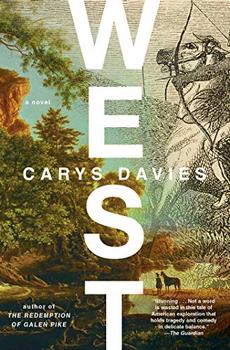Book Club Discussion Questions
In a book club? Subscribe to our Book Club Newsletter and get our best book club books of 2025!
For supplemental discussion material see our Beyond the Book article, The Lewis and Clark Expedition and our BookBrowse Review of West.
Please be aware that this discussion guide will contain spoilers!
- West opens on the morning Bellman is preparing to leave his farm in Pennsylvania to head to the unsettled territories. What does "west" mean to Bellman, and how does its significance contrast with what it represents for his daughter, Bess, his sister, Julie, and his neighbor, Elmer Jackson?
- Bellman can only explain his response to the giant animal bones in terms of bodily sensations: "There were no words for the prickling feeling he had that the giant animals were important somehow, only the tingling that was almost like nausea and the knowledge that it was impossible for him, now, to stay where he was" (p. 16). How would you articulate, using the words he can't summon, the reasons that the animals ignite such a profound yearning in Bellman?
- Why does Old Woman From A Distance choose to leave the Shawnees in favor of working with Devereux and Mr. Hollinghurst? Why does he then leave them to go with Bellman as a guide even though he knows the giant animals aren't out there? What does Old Woman's behavior toward these men reveal about his worldview, his hopes, his fears, and his deepest desires?
- Bellman's route to the West is retraced by Old Woman when he journeys east to deliver the letters to Bess. How do the two men experience the same terrain differently? How do they influence each other along the way?
- West is narrated by a chorus of characters both principal and ancillary: Bellman, Bess, Old Woman From A Distance, Devereux, Elmer Jackson, the librarian, Mary Higson, and an omniscent narrator, among others. How did the shifting perspectives contribute to your enjoyment of the novel? Which character's perspective did you relate to the most? The least?
- In Bellman's thoughts, Aunt Julie is often accompanied by a variation of the epithet "perhaps softer on the inside than she was on the out." Do you think this is a fair assessment of Julie's character? In what ways does she challenge it?
- By the time Bellman meets his fate in the vast wilderness of the West, he is very, very far from his first home in England, a place he describes as "small and dark and cramped'' (p. 111). How do you interpret Bellman's feelings toward the notion of home at this point? Is he more or less ambivalent toward where he comes from than when he first left Lewistown? Did learning that Bellman has already made a journey from England to America change the way you think about his decision to continue west from Lewistown?
- Aunt Julie regards Bellman as a fool; to Bess he is "grand and purposeful and brave" (p. 2). Knowing what happens, whom do you agree with more?
- On page 113, Bellman thinks, "You had so many ways of deciding which way to live your life. It made his head spin to think of them." What does he mean?
- Bess will never know for sure what Old Woman was thinking while she was retrieving water for him at the pump. What do you think was going through his mind before fleeing? Where do you imagine he is headed after leaving Bellman's farm?
- West ends with a sequence dense with images that tie together elements from the entire story. Trace the journey of the objects in the images—the knitting needle, Elsie's blouse, Bellman's compass—and how their purposes have transformed.
- West has been called a parable of the early American frontier. Is there a lesson to be learned from this story?
Enhance Your Book Club
- The discovery of colossal animal bones that catches Bellman's imagination in West is based on true events: In the late 18th century, Pleistocene megafauna fossils were discovered in northern Kentucky, and in fact, at many other sites across the United States as well. Research this chapter of paleontological history, including Thomas Jefferson's own obsession with mammoths, and share your findings with the group.
- Bess spends many hours at the subscription library in Lewistown poring over the maps and journals from Lewis & Clark's expedition. Do some poring over these artifacts yourself online at https://lewisandclarkjournals.unl.edu/ and discuss your findings with the group.
Unless otherwise stated, this discussion guide is reprinted with the permission of Scribner.
Any page references refer to a USA edition of the book, usually the trade paperback version, and may vary in other editions.
